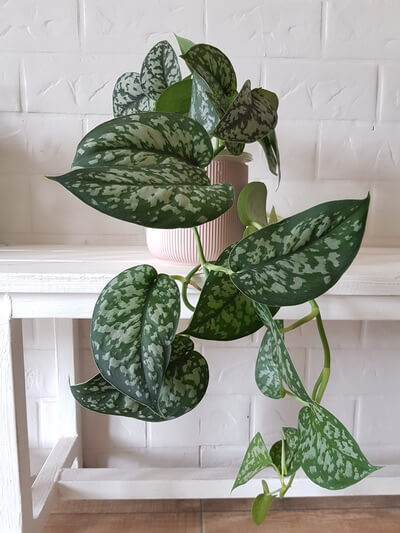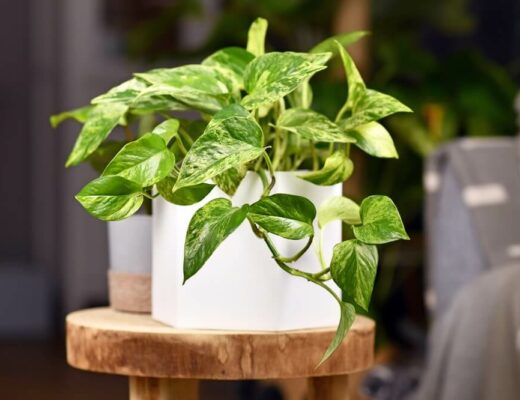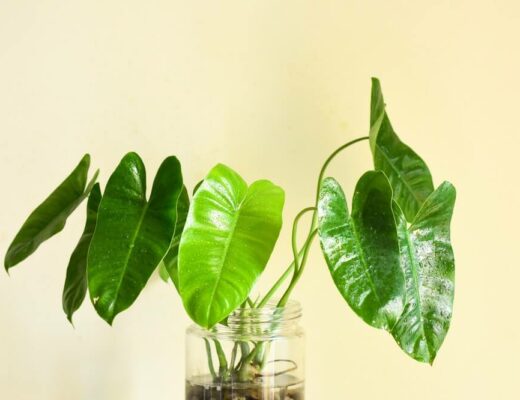The Silver Satin pothos is a variety of vining pothos. It’s often used as an ornamental houseplant, useful for its attractive foliage and air purifying properties. As far as houseplants go, it’s extremely beginner-friendly. Silver Satin pothos care is straightforward and easy to perfect!
The Silver Satin pothos, whose scientific name is Scindapsus pictus, boasts dainty, green heart shaped leaves that are variegated with flecks of a cool blue-silver. This plant is intriguing to look at and can be trained to grow up a moss pole or trellis or it can trail from a hanging basket.
Table of contents
Quick Facts

- Common Name: Silver Satin Pothos
- Scientific Name: Scindapsus pictus
- Mature Size: 4 to 10 feet long
- Sunlight: bright, indirect/filtered sunlight
- Water: water thoroughly and allow top half of soil to dry
- Soil: nutrient rich, arid/well-draining soil
- Temperature: 65°F-85°F
- Hardiness Zone: 9-11
- Propagation: stem cuttings
- Toxicity: toxic to pets and humans
Growth Pattern and Habits
Originating from Southeast Asia, the Silver Satin pothos plant normally grows on the trunks of trees just under the canopy. Thanks to its tropical origins, it grows very well under controlled, indoor conditions. The plant can be identified by its heart-shaped leaves, which feature a variegated pattern of silver and green. Its vines can reach a maximum length of ten feet when grown outdoors and four feet when grown indoors in a container.
Relatively speaking, the Silver Satin pothos is pretty low-maintenance. In fact, it’s sometimes called “devil’s ivy” because it’s difficult to kill once it’s been established. Occasional watering, fertilizing, and pruning is all it takes to keep this plant thriving season after season.

Like other pothos varieties, the Silver Satin subspecies grows vines that will latch onto any surrounding forms of support, including nearby furniture, electrical wires, and porous walls. With this in mind, you can train your Silver Satin pothos to climb by placing hooks, trellises, or poles nearby. Alternatively, you can place this plant in a hanging container and let the vines grow over its sides for an attractive draped effect.
Providing adequate climbing supports will help your Silver Satin pothos produce mature, impressive, broad leaves. On the other hand, pruning the ends of your vines during the growing season will encourage it to grow bushier and fuller. If you notice roots extending out from the bottom of your container, it’s time to repot your satin pothos in a larger container.
Sunlight
The Silver Satin pothos needs bright, indirect light for best growth but can tolerate lower levels of indirect light. A long vine with few, small leaves or leaves with little color variation are sure signs of a plant that craves more light. Meanwhile, exposure to too much direct sunlight can scorch its leaves and cause them to dry out or lose their color.

To provide the best care for a Silver Satin pothos, you should position it away from direct sunlight or with the protection of a filter, such as a translucent curtain. This plant grows very well in a room with an east-facing window where it can receive light reflected off of white-painted walls.
In a room with a south or west-facing window, the plant will do best when it’s placed near the center of the room or on a shelf a couple feet away from where direct sunlight touches.
Water
Overwatering, which eventually leads to root rot, is the most common mistake made by novice pothos keepers. The plant’s waxy leaves give it the ability to retain water quite well, lowering the watering frequency necessary to keep it alive. As a rule of thumb, water the plant when the top half of the soil feels dry to the touch, and stop watering when the soil becomes completely saturated.

Most people can get away with watering their pothos once every week or two, depending on the local climate. The best way to tell if your plant needs to be watered is to look for slightly curled leaves and bone-dry topsoil. If your satin pothos receives a lot of sunlight or warmth, it will exhibit more growth during the active growing season and consume more water as a result.
Soil
The Silver Satin pothos likes well-draining soil and a container with drainage holes. In most cases, you’ll do just fine with a commercial, well-draining potting mix. If you want to boost your soil’s drainage capabilities, consider mixing in some perlite, pumice, bark chips, or coconut coir.

You can also choose to make your own homemade potting mix. I prefer an equal mix of the following as the soil for my Silver Satin pothos:
- Organic potting mix or earthworm castings
- Perlite
- Coconut Coir or peat moss
Temperature and Humidity
Native to tropical regions such as Thailand, Indonesia, and Bangladesh, the Silver Satin pothos isn’t very cold-tolerant and prefers a temperate environment, which is why it thrives as an indoor-only plant. The ideal temperature range is 65-85°F, but the plant is pretty forgiving overall as long as it receives enough water and light. If you live in a dry, arid climate, you can meet the plant’s humidity needs by placing the container on a pebble tray or lightly misting the plant once every few days.
Fertilization
Apply a general houseplant fertilizer with equal parts nitrogen, phosphorus, and potassium every month in the spring and summer. At this time of year, your Silver Satin pothos will convert sunlight and warmth into active growth, requiring extra nutrients as a result.
Stop fertilizing if you notice any browning around the leaves, which is a sign of scorching from over fertilized soil. Don’t fertilize at all during the fall and winter months when the plant goes dormant.
Propagation
You might find that your Silver Satin pothos plant grows so much in the summer, you have no choice but to propagate. Plant rooted cuttings in the same container as the host plant to help it appear fuller or in a brand new pot to give to a friend. To accomplish this successfully, you can use one of two tried-and-true methods of Silver Satin pothos propagation.

Silver Satin Pothos Propagation in Water
This is one of the most beginner-friendly ways to propagate any plant, including the Silver Satin pothos. First locate the nodes of your plant, which are small bumps along the vine where new leaves begin to sprout. Cut the end off a vine with a clean pair of scissors, leaving one or two inches of stem below the last node. Make sure to choose a cutting with a few healthy leaves before you sever it from the plant.

Once you have a few suitable cuttings, place the stems in a container of clean, room-temperature water, making sure that no leaves are submerged. Place the container in an area with bright, indirect sunlight and wait for roots to form, which will take a few weeks. Once the roots have reached a length of two to three inches, you can transfer the cutting out of the water and plant it into a container of fresh soil. At this time, start implementing care as you would for a mature Silver Satin plant.
Note: Replenish the container with fresh water very 2-3 days, or more frequently if you notice the water is discolored!
Silver Satin Pothos Propagation in Soil
The soil method is very similar to the water method of Silver Satin pothos propagation. Instead of a container of water, place your cuttings in a container of soil. Bury each cutting deep enough to cover the last node and keep the plant upright, but avoid burying any leaves.
Water it just enough to keep the soil moist until a root system forms, which should take about a month. Once roots are established, begin care for your Silver Satin pothos as you would for a mature plant.

Alternatively, position your cutting horizontally across the soil with the nodes facing down and the leaves facing up. You can use bobby pins or paper clips to stake them in place until the nodes grow roots, allowing them to secure themselves to the soil. This will produce a wider, fuller plant compared to a cutting that’s planted upright.
Common Problems
Root Rot
The most common issue plaguing the Silver Satin is root rot, which is caused by overwatering or a poorly-draining substrate. Early symptoms include a wilting plant or yellowing leaves. To remedy this, stop watering until your plant improves. Poking a few holes into the soil will help air out the roots and speed up the plant’s recovery. This is called aerating.

A satin pothos in the advanced stages of root rot can only be saved by transplanting it. Carefully uproot the plant and shake off excess soil to expose the roots. Prune off any blackened or rotten root sections and replant in fresh soil. If the root rot was caused by poor drainage rather than overwatering, you should make sure that you are replanting the pothos in improved conditions.
Root rot isn’t the only reason that a Silver Satin pothos has yellowed leaves. Read the full post on everything about yellowing pothos leaves.
Spider Mites
Spider mites are microscopic arachnids that colonize a plant’s leaves to suck up its fluids. With enough time, an infestation can destroy leaves and kill the plant. Signs of an infestation include light spots, dry leaves, and fine, white webbing on the underside of leaves and around the stem.
If you notice any signs of spider mites, pick off the affected leaves and dispose of them in the trash. If the entire plant is affected, treat it with a commercial pesticide that’s specifically designed for houseplants, paying special attention to the stems and under the leaves. Diluted neem oil is another remedy that can be used to combat spider mite infestations without relying on chemical-based pesticides.

Scale
A close relative of the aphid, scale insects are often smaller than a pinhead and difficult to see with the naked eye. They feed by piercing the host plant with their needle-like mouths to suck up nutritious sap. Sometimes, they appear as tiny, scale-like growths along your plant’s stem. If you can’t see any actual scale insects, your plant will show other signs of infestation, such as dying leaves or stunted growth.
To treat a pothos infested with scale, first scrape off any visible insects with your fingernail or a cotton swab dipped in alcohol. Then, rinse off the plant with water or very mild, soapy water daily until the infestation clears. For additional protection, treat your pothos and any other indoor plants with a solution of neem oil to prevent future infestations.
Toxicity
Like all pothos, the Silver Satin pothos contain insoluble calcium oxalate crystals, which are extremely sharp crystals that can be compared to microscopic shards of glass. These are toxic to both humans and pets. Chewing on a pothos leaf will pierce soft tissue and cause localized mouth pain, irritation, or swelling. In rare cases, the upper airway can become irritated and swollen, leading to breathing difficulties. Contact with the plant’s juices can also cause skin irritation.
Treat any possible oxalate exposure by immediately rinsing the area with water. If the exposure occurred in the mouth, follow the rinse with some milk or yogurt. The crystals will bind to calcium molecules and help manage symptoms. Contact emergency services if you experience worsening symptoms or breathing difficulties.
Silver Satin Pothos Varieties
Remember that the Silver Satin pothos’ scientific name is Scindapsus pictus. There are a handful of Scindapsus pictus varieties that are just as unique as the Silver Satin pothos that I want to share with you! These pothos varieties require very similar care to what was detailed in this care guide. For general pothos care, check out my post on pothos care 101!
Scindapsus pictus ‘Jade Satin’ is a beautiful variety of the Silver Satin pothos. While it doesn’t boast much variegation, the green leaves do have a silvery sheen that makes the plant look like it’s covered in alluring velvet.

Another beautiful variety is the Scindapsus pictus ‘Silver Lady’. As its name suggests, this plant’s leaves are heavily covered in a pixelated silver variegation with relatively little green. The ‘Silver Lady’s’ leaves are broader than that seen in the Silver Satin pothos.
Scindapsus pictus ‘Argyraeus’ is a much more delicate variety. While still retaining the asymmetrical heart shaped leaves of its relatives, the ‘Argyraeus’ has smaller, rounder leaves. Their green leaves are a lighter green than that of a ‘Jade Satin’ and have soft blotches of silver variegation.

Wrapping Up
The Silver Satin pothos is an ideal indoor house plant and can be grown either in a hanging basket or in a pot with a moss pole as a vining plant. Its silver iridescence is beautiful to observe in bright rooms. I hope you enjoy this tropical plant as much as I do!




